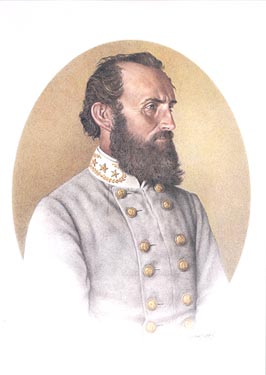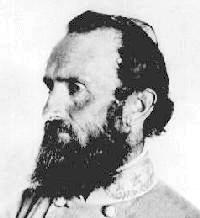
Thomas J. Jackson
Thomas Jonathan Jackson was born January 21, 1824, in Clarksburg, Virginia. His parents died while he was still a child, and he was raised by an uncle at Jackson’s Mill in western Virginia.
In June of 1842, he was appointed to West Point. Following his graduation in 1846, he served with General Winfield Scott in the Mexican War, earning two brevets before resigning as a Major to accept a position as professor with the Virginia Military Institute, where he became known as an eccentric.
One of his passions was religion. While he was at the Virginia Military Institute, he taught a Negro Sunday School, and preferred the company of theologians to soldiers.
Upon the outbreak of the American Civil War, he was commissioned a Colonel in the Virginia forces, serving at Harper’s Ferry until he was relieved by Joe Johnston.
His advancement was rapid, and, next to Robert E. Lee himself, he became the most revered of all Confederate commanders.
General “Stonewall” Jackson was the only Confederate general who devised an effective countermeasure against McClellan’s war machine. Realizing that the Confederacy couldn’t match force with force, he found a better way to ward off defeat.
 As a former professor of natural sciences, he conformed his military thinking to the well-known axiom of physics that energy equals mass times the square of velocity. Since the Confederacy could not match the Union forces in mass, compensation might be attained by superior velocity. McClellan’s bulldozer-type war machine was powerful, yet slow and clumsy; therefore, Jackson developed his own strength in speed and agility, seen most clearly in his famous foot cavalry.
As a former professor of natural sciences, he conformed his military thinking to the well-known axiom of physics that energy equals mass times the square of velocity. Since the Confederacy could not match the Union forces in mass, compensation might be attained by superior velocity. McClellan’s bulldozer-type war machine was powerful, yet slow and clumsy; therefore, Jackson developed his own strength in speed and agility, seen most clearly in his famous foot cavalry.
The first testing ground for this method of warfare was the Shenandoah Valley, but the enemy there was scattered; so it was not until the 2nd Manassas (Bull Run) campaign that the superiority of speed and agility over mass and clumsiness was clearly demonstrated.
Although greatly outnumbered in force, Jackson ran rings around several Union army corps, driving Pope into confused helplessness.
His performance was less than spectacular at Gaine’s Mill and Cedar Mountain, where speed was of secondary importance; and he failed miserably against McClellan on the Peninsula. The usual explanation is that he worked best as an independent commander, but the most likely reason is that his tactics worked best where he had an opportunity to use speed and agility.
In the Shenandoah Valley, he was confronted by a splintered bulldozer, and was able to slap down all of its pieces in turn. At Antietam, it was speed that enabled him to join Lee at a crucial hour. At the 2nd Battle of Manassas, he made the Union forces chase him, shattering itself against his defenses.
At Chancellorsville, he stopped the bulldozer in its tracks. Jackson, however, was killed at Chancellorsville, and his foot cavalry died with him.
Jackson’s performance in battle ranged all the way from excellent to bad.
While there was criticism that his military tactics were behind the times, he clearly realized that the true military objective was the total destruction of the enemy and not the conquest of territory.
His death at Chancellorsville was perhaps the weightiest blow that the Confederacy had sustained.